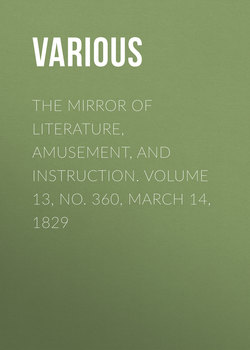Читать книгу The Mirror of Literature, Amusement, and Instruction. Volume 13, No. 360, March 14, 1829 - Various - Страница 2
GRAND ENTRANCE TO HYDE PARK
ОглавлениеThe great Lord Burleigh says, "A realm gaineth more by one year's peace than by ten years' war;" and the architectural triumphs which are rising in every quarter of the metropolis are strong confirmation of this maxim.
One of these triumphs is represented in the annexed engraving, viz. the grand entrance to Hyde Park, erected from the designs of Decimus Burton, Esq. It consists of a screen of handsome fluted Ionic columns, with three carriage entrance archways, two foot entrances, a lodge, &c. The extent of the whole frontage is about 107 feet. The central entrance has a bold projection: the entablature is supported by four columns; and the volutes of the capitals of the outside column on each side of the gateway are formed in an angular direction, so as to exhibit two complete faces to view. The two side gateways, in their elevations, present two insulated Ionic columns, flanked by antae. All these entrances are finished by a blocking, the sides of the central one being decorated with a beautiful frieze, representing a naval and military triumphal procession, which our artist has copied and represented in distinct engravings. This frieze was designed by Mr. Henning, jun., son of Mr. Henning, so well known for his admirable models of the Elgin marbles. It possesses great classical merit, and the model was exhibited last season in the sculpture-room of the Suffolk-street Gallery.
The gates were manufactured by Messrs. Bramah. They are of iron, bronzed, and fixed or hung to the piers by rings of gun-metal. The design consists of a beautiful arrangement of the Greek honeysuckle ornament; the parts being well defined, and the raffles of the leaves brought out in a most extraordinary manner. The hanging of the gates is also very ingenious.
Mr. Soane's proposed entrances to Piccadilly and St. James's and Hyde Parks, are generally considered superior to those that have been adopted. The park entrances were to consist of two triumphal arches connected with each other by a colonnade and arches stretching across Piccadilly. The same ingenious architect likewise designed a new palace at the top of Constitution Hill, from which to the House of Lords the King should pass Buckingham House, Carlton House, a splendid Waterloo and Trafalgar monument, a fine triumphal arch, the Privy Council Office, Board of Trade, and the new law courts.
